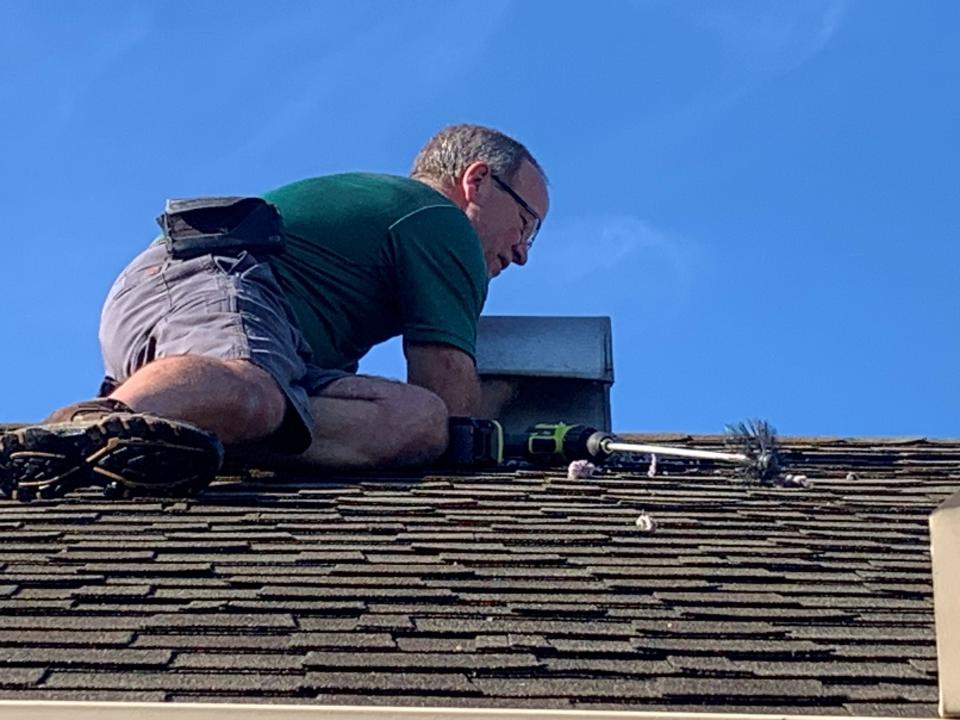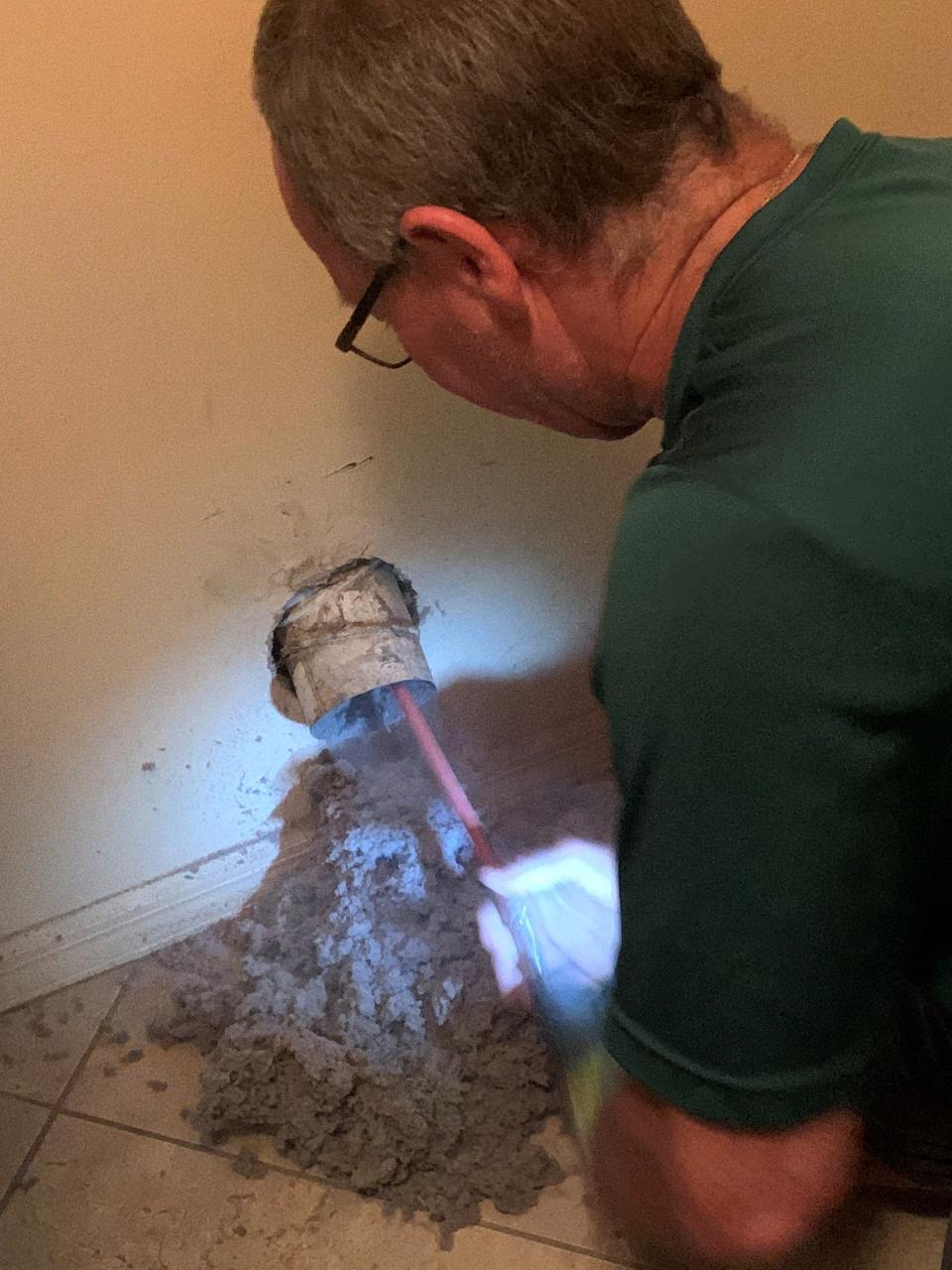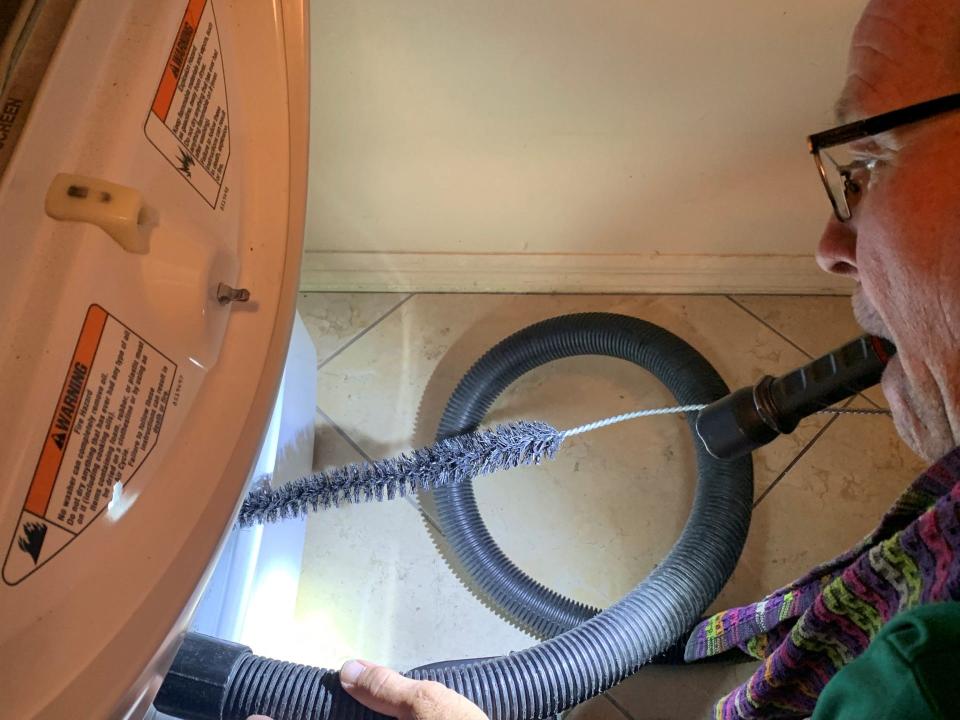How dangerous is dryer lint? Treasure Coast vent man, fire marshal, Florida stats sum up
I didn’t call Ryan Arledge to prevent a fire. At my age, I just figured it was prudent to pay someone to climb on our roof to perform preventive maintenance.
I got and learned way more than I had expected.
About four years ago, our clothes dryer stopped drying. A repairman came out and, before fixing the dryer, showed me how much lint had built up inside the machine.
I was flabbergasted.
He recommended taking the dryer front off and cleaning the inside every couple of years. He suggested clearing the dryer vent on the roof, which he, as an appliance technician, was unable to do. I hadn’t been up there for years, so I got my son to do it.
Ominous warning on the van

A few months ago, I started looking for someone to clean the roof vent and inside of the dryer in much less time than it would take me.
Some companies would do one task, but not the other. Arledge, 57, a St. Lucie County native who said he spent 30 years as an appliance technician, including 15 cleaning dryer vents, would do both. He started his own business, Mastertech Dryer Vent Cleaning, about six years ago.
I figured Arledge would be in and out. I was wrong.
He drove up in a van emblazoned with this message: “Don’t wait until it’s too late! Lint build up can cause fires.”
Arledge pulled out a tall, high-powered vacuum and a golf bag full of long, thin, flexible plastic sticks ― the kind my wife, as a golf pro, stuck in the ground to help duffers who'd sway off the ball. Some of Arledge's sticks were attached to brushes.
His first task was one we used to do with a long, snake-type brush we’d stick up the chute behind our dryer that headed toward the roof. But Arledge started with one short stick attached to a power drill and started brushing the vent. He attached more sticks to get higher.
Lint leads to changing the dryer transition tube

By the time he was done, he had a large pile of lint ― enough to make a good contribution to what in 2019 became a Port St. Lucie company’s Guinness world record lint ball, as reported by TCPalm.
Arledge then got on the roof and cleaned the vent. He freed so much he made a second trip up his ladder with a blower to clear it off.
Back inside, Arledge unscrewed the dryer cover and showed me how much lint avoided the screen.
For $25 (on top of his $150 cleaning fee), he installed a flexible, but more metal-based, dryer transition tube, running from the dryer to the wall vent. He showed how it would not be as flammable as the softer one I had.
Just how big of a deal were dryer fires, I asked. Arledge said, and I confirmed this with the National Fire Protection Association, there are about 15,000 each year nationwide.
That sounded like a lot, but maybe that meant 1,000 or so in Florida?
The Florida State Fire Marshal’s Office was concerned enough about the issue in 2019 it issued a "Fire Safety Consumer Alert" about dryer fires. It offered tips, including cleaning the vent, on how to avoid being one of the "12,900 home fires involving clothes dryers or washing machines each year. These fires resulted in annual losses estimated at $211 million in property damage with 10 deaths, 360 injuries."
Florida fire numbers make things confusing
The office sent me a spreadsheet listing, by county, nearly 3,000 dryer-related fires recorded the past 10 years.
They listed 37 in Martin (13), St. Lucie (13) and Indian River (11) counties the past 10 years, with a high of five in 2013 and 2014 in St. Lucie. The report showed St. Lucie, whose population is about twice that of the other counties, has not had a lint fire since 2018.
The numbers confused me, especially given that TCPalm has covered numerous dryer fires over the years, including in 2020, when six people had to flee an apartment in Vero Beach.
For more context, I called Jon Pasqualone, a Hobe Sound resident and executive director of the Florida Fire Marshals and Inspectors Association. He said dryer fires are a real threat, but likely are underreported.
Review data and make your own decision

“It’s not because of anyone’s negligence,” Pasqualone said. “It’s just the way the (fire) reporting system is set up.”
He said his association, which represents about 1,400 fire marshals, and the State Fire Marshal’s Office has asked the Legislature to fund improvements to the reporting system.
Post-fire inspections and reporting, he said, can be inconsistent across various fire departments. Some agencies, for example, might not classify a fire that engulfed an attic as a dryer fire, even if the major contributor was a clogged duct.
Could cleaning your dryer save you money?
Pasqualone then cited the 2022 annual report from the State Fire Marshal’s Office listing 14,299 structure fires.
The office listed 12% as an “act of nature” (1.78%), intentional (3.34%) or “cause under investigation” (7.2%). “Failure of equipment or heat source” (9.01%) and a vague “unintentional” (32.27%) were the next largest numbers.
The most vague number clocked in at 46.39% of all structure fires: “cause undetermined after investigation.”
That’s shocking. How can emergency management officials and Floridians know exactly what steps to take to prevent fires if we don’t know exactly what causes so many of them?
One hint might be the U.S. Fire Administration, which in 2017 listed the main causes of single- and two-family residential home fires over two years.
Appliances made up about 9% of the fires with known causes, slightly behind cooking (10%) and electric malfunctions (15.4%). Still, the administration listed 13.8% as “other unintentional, careless.” Of all fires in the report, the vast plurality, 26.6%, happened for unknown reasons.

Pasqualone said cleaning dryer vents should be considered routine maintenance and prevention, just like regularly checking the batteries in a smoke detector.
In 2019, the owner of the Port St. Lucie company that built the world-record lint ball told TCPalm fire prevention is only one reason to keep your ducts clean.
"People don’t realize that not maintaining their machines will also overwork it, shorten the lives of the equipment and cost them more money — up to an extra $18 a month — to run the machines,” George Perez, owner of Dryer Vent Wizard said.
I'm just the messenger. Regardless, I’m all for potentially saving money, preventing fires and, perhaps most importantly, staying off the roof.
This column reflects the opinion of Laurence Reisman. Contact him via email at larry.reisman@tcpalm.com, phone at 772-978-2223, Facebook.com/larryreisman or Twitter @LaurenceReisman.
If you are a subscriber, thank you. If not, become a subscriber to get the latest local news on the latest local news on the Treasure Coast.
This article originally appeared on Treasure Coast Newspapers: Vero Beach area dryer vent cleaner prompts lint fire risk assessment

